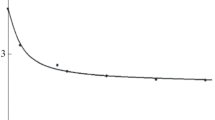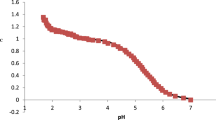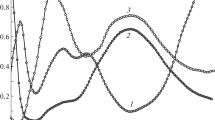Abstract
Base hydrolysis of [Cr(ox)2(pda)]3− (where pda is N,O-bonded 2,4- and 2,5- pyridinedicarboxylic acid dianion) causes successive ligand dissociation and leads to formation of a mixture of oligomeric chromium(III) species, known as chromates(III). The main reaction path proceeds through [Cr(ox)(pda)(OH)2]3− and [Cr(pda)(OH)4]3− complexes. The kinetics of the first oxalate dissociation was studied spectrophotometrically, within the lower energy d–d band region, at 0.4–1.0 M NaOH. The character of spectroscopic changes was consistent with a consecutive reaction model, where the chelate-ring opening and the one-end bonded oxalato liberation are the first and the second reaction stages. The pseudo-first order rate constants (k obs0 and k obs1) were calculated using SPECFIT software for an A → B → C reaction pattern. Additionally, kinetics of base hydrolysis of [Cr(ox)3]3− were studied. The calculated rate constants were independent of [OH−]. Kinetic parameters for the chelate-ring opening and the first oxalate dissociation were determined. Effect of the [Cr(ox)2(pda)]3− and [Cr(2,4-pda)3]3− complexes on 3T3 fibroblasts proliferation was studied. The results manifested low cytotoxicity of these complexes, which makes them promising candidates for dietary supplements.






Similar content being viewed by others
References
George GN (2006) In: Kraatz H-B, Metzler-Nolte N (eds) Concepts and models in bioorganic chemistry. Wiley-VCH, Weinheim
Mertz W (1993) J Nutr 123:626
Vincent JB (1999) J Am Coll Nutr 18:6
Trent LK, Tiedingcancel D (1995) J Sports Med 35:273
Vincent JB (2001) Polyhedron 20:1
Anderson RA (2000) Diabetes and metabolism 26:22
Kita E, Gołembiewska K (2007) Transit Met Chem 32:56
Kita E, Marai H, Zając K (2008) Transit Met Chem 33:211
Kita E, Marai H, Jasiński M, Drewa T (2008) Transit Met Chem 33:585
Kita E, Marai H, Iglewski Ł (2009) Transit Met Chem 34:75
Kita E, Marai H (2009) Transit Met Chem 34:585
Kita E, Marai H, Jach K, Orłowska A (2009) Transit Met Chem 34:217
Richens DT (2005) Chem Rev 105:1961
Inorganic synthesis (1979) vol. XVII, McGraw-Hill Book Company, New York, p 149
Rao L, Zhang Z, Friese JI, Ritherdon B, Clark SB, Hess NJ, Rai D (2002) J Chem Soc Dalton Trans 267
Helm L, Merbach AE (2005) Chem Rev 105:1923
Basolo F, Pearson RG (1967) Mechanism of inorganic reactions, 2nd edn. Wiley, New York
Jordan RB (1998) Reaction mechanisms of inorganic and organometallic systems, 2nd New York. Oxford University Press, Oxford
Slesinski RS, Clarke JJ, San RHC, Gudi R (2005) Mutation Res 585:86
Shrivastava HY, Ravikumar T, Shanmugasundaram N, Babu M, Unni Nair B (2005) Free Radic Biol Med 38:58
Acknowledgments
Hasan Marai wishes to thank Libyan Government for financial support of his Ph.D. studies in Poland.
Author information
Authors and Affiliations
Corresponding author
Rights and permissions
About this article
Cite this article
Kita, E., Marai, H., Michał, L. et al. Mixed-ligand chromium(III)-oxalate-pirydinedicarboxylate complexes: potential biochromium sources: kinetic studies in NaOH solutions and effect on 3T3 fibroblasts proliferation. Transition Met Chem 35, 177–184 (2010). https://doi.org/10.1007/s11243-009-9311-z
Received:
Accepted:
Published:
Issue Date:
DOI: https://doi.org/10.1007/s11243-009-9311-z




